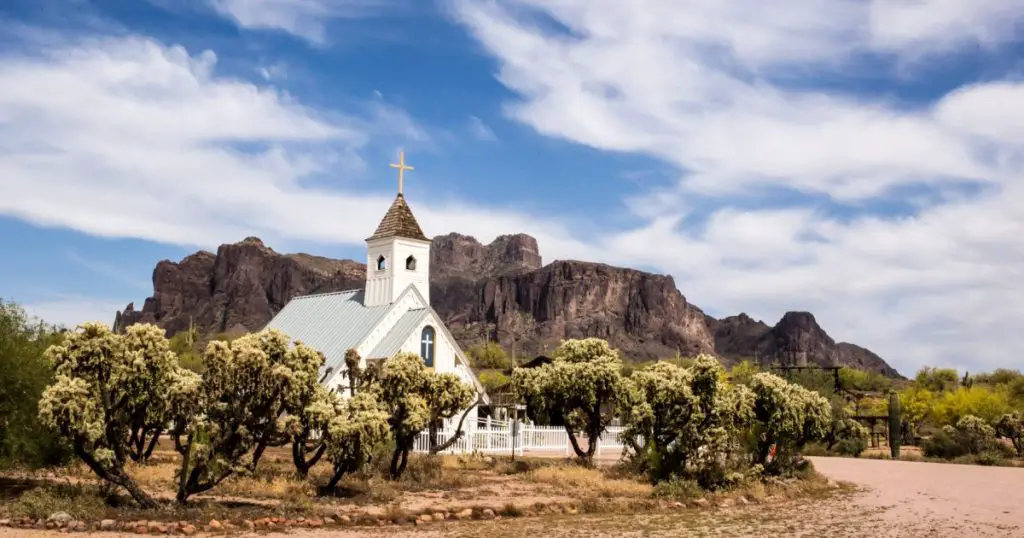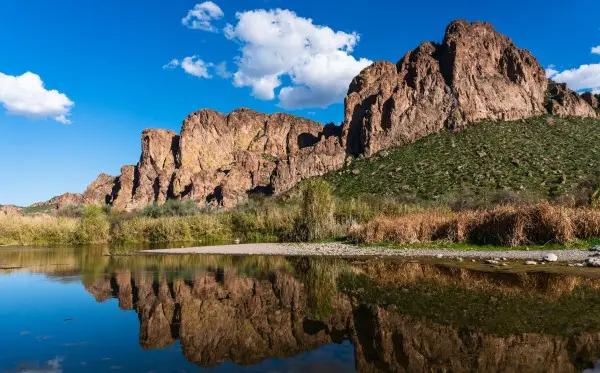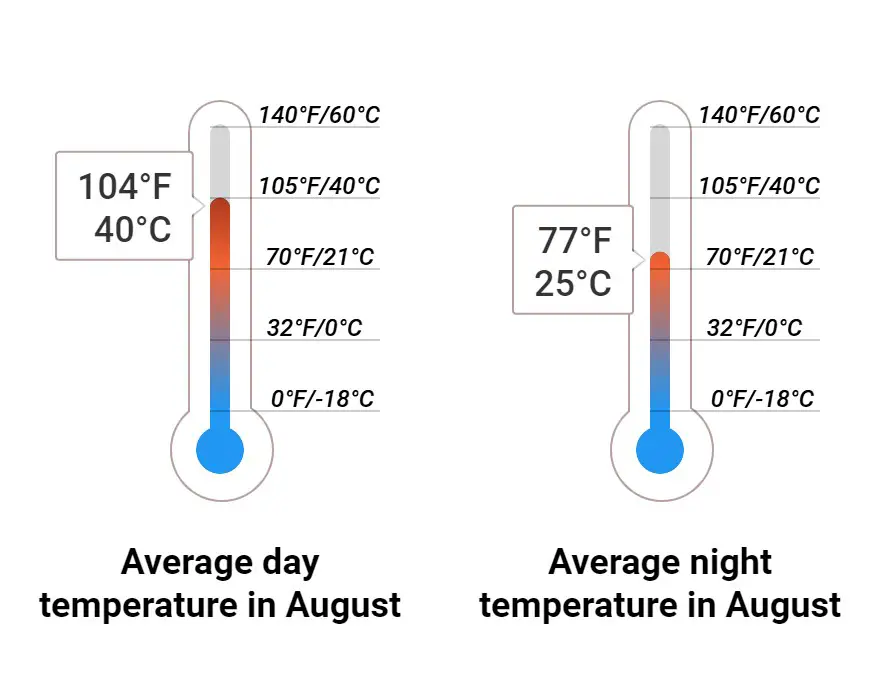Diving into the warmth of the Southwest, we’re turning the spotlight onto the captivating city of Mesa, Arizona. Home to stunning desert landscapes and vibrant culture, Mesa stands out with its unique, sun-drenched climate.

Today, we’re exploring the intriguing subject of the average temperature in Mesa, AZ and how it shapes the lifestyle, activities, and the environment in this beautiful city.
Understanding the Climate of Mesa, AZ
Mesa’s climate dances to the tune of the sun, offering warmth that is both comforting and, at times, intense. Understanding this climate is crucial to appreciating the city in its entirety. So, what exactly characterizes Mesa’s weather?
The climate of Mesa, AZ is classified under the Köppen-Geiger climate classification as BWh, signifying a hot desert climate. This type of climate is typically marked by high temperatures, low humidity, and minimal rainfall. Learn more about the Köppen-Geiger system and its climate classifications.
Detailed Monthly Breakdown of Mesa, AZ’s Average Temperatures
A detailed monthly breakdown of Mesa, AZ’s average temperatures reveals a gradual climb in heat throughout the year. Starting in January, the city experiences a mild winter with an average high temperature of around 67°F (19.4°C). As the year progresses, the temperatures gradually increase, reaching an average high of 103°F (39.4°C) in July, the hottest month.
The rest of the summer continues to be hot, with temperatures slowly dipping as autumn approaches. By December, the average high drops back to around 67°F (19.4°C), closing the annual temperature cycle. This pattern of warm winters and hot summers is characteristic of Mesa’s desert climate.
The Cool Embrace: January’s Average Temperature
Despite being in the heart of the desert, Mesa does experience a winter season, albeit a mild one. January stands as the coolest month, offering residents and visitors a respite from the relentless heat.
The average high temperature hovers around 67°F (19.4°C), while the average low dips down to around 41°F (5°C). The National Weather Service provides regular updates about weather conditions in Mesa and other cities.
During this month, the mild temperatures make outdoor activities enjoyable. Whether it’s hiking, golfing, or exploring the city’s rich cultural sites, January presents the perfect weather for all.
The Transition: February’s Average Temperature
February in Mesa brings a hint of change. The city starts its slow march towards warmer temperatures, with the average high increasing to around 70°F (21.1°C) and the average low to about 44°F (6.7°C). This slight elevation in temperature makes February a transitional month between the relatively cooler winter and the impending spring.
The month is often adorned with blue skies and infrequent rains, making it yet another perfect time for outdoor exploration. The Weather Channel offers detailed weather forecasts for Mesa and can be a handy resource.

The Onset of Heat: March’s Average Temperature
Come March, and you can feel the Mesa sun start to flex its muscles. The average high temperature in Mesa in March catapults to around 77°F (25°C), with the average low resting at around 51°F (10.6°C). But worry not, the warmth is gentle and the weather is still pleasant, courtesy of the low humidity.
The shift from mild to warm temperatures signifies the onset of spring. Local outdoor activities such as the Mesa Arts Center’s concerts and festivals typically start ramping up, taking advantage of the pleasant weather.
Remember, each month brings a distinct flavor to Mesa’s climate, each offering a unique experience. The rest of the year follows a similar, albeit gradually hotter, trend.
Comparing Mesa’s Average Temperature to Other Arizona Cities
When comparing Mesa’s average temperatures to other Arizona cities, a diverse range of climates within the state becomes apparent. Phoenix, located nearby, shares a similar desert climate with Mesa, marked by high summer temperatures and mild winters.
However, the summer months in Phoenix are slightly hotter. Tucson, in southern Arizona, experiences marginally cooler summers due to its higher elevation. In contrast, Flagstaff, in northern Arizona, has a significantly cooler climate because of its location in the higher altitude regions of the state. This diversity underscores the complexity of Arizona’s climate, shaped by geography and altitude.
Mesa vs. Phoenix: A Temperature Comparison
Phoenix, Arizona’s bustling capital, is a neighboring city to Mesa. Despite their proximity, there are subtle differences in their climates. Phoenix’s average high temperature in January is around 67°F (19.4°C), quite similar to Mesa’s. However, the summer months tend to be slightly hotter in Phoenix than in Mesa, with Phoenix’s July average high touching 105°F (40.6°C) compared to Mesa’s 103°F (39.4°C).
Phoenix and Mesa share many similarities in their climate, thanks to their geographical proximity and similar desert landscapes. However, the slight variations are worth noting, especially for those planning to move or visit.
BMesa vs. Tucson: A Tale of Two Cities
Tucson, located in southern Arizona, offers another interesting comparison. Tucson’s January temperatures are similar to those of Mesa, with an average high of around 66°F (18.9°C).
However, Tucson’s July average high temperature is marginally lower at around 100°F (37.8°C). Tucson’s slightly higher elevation compared to Mesa explains the minor differences. Despite these differences, both cities share the common trait of a hot desert climate.
Mesa vs. Flagstaff: Exploring Contrasting Climates
Flagstaff, located in the northern part of the state, presents a stark contrast. Unlike Mesa, Flagstaff experiences a cold semi-arid climate due to its high elevation. Flagstaff’s January temperatures are significantly lower, with average highs reaching only 43°F (6.1°C).
The July average high is much cooler as well at about 81°F (27.2°C). This makes Flagstaff a popular escape during the summer for residents of hotter Arizona cities, like Mesa.

The Impact of Mesa’s Climate on Lifestyle and Activities
Mesa’s desert climate significantly shapes the city’s lifestyle and activities. The hot temperatures influence architectural design, with homes built to keep cool during the scorching summer months. Outdoor spaces often feature pools and shaded areas to offer relief from the heat.
Water conservation is a crucial aspect of life, given the arid environment. Despite the heat, outdoor activities like hiking, biking, and golf are popular during cooler months, while indoor attractions become a haven during the summer. The distinct seasons in Mesa shape a dynamic rhythm of life, each bringing its unique set of activities and experiences.
Adapting to the Heat: Lifestyle in Mesa
Living in Mesa means adapting to the sun. This is evident in the city’s architecture, with homes designed to keep cool during the hot summer months. The use of shade, either through landscaping or architectural design, is a common feature.
Outdoor living spaces often have pools and shaded patios. Water conservation is a priority given the arid climate. Even the city’s flora reflects this adaptation, with native plants like the saguaro cactus and palo Verde trees thriving in the desert heat.
Activities for Every Season: Embracing Mesa’s Climate
Despite the heat, Mesa boasts a vibrant outdoor culture. In cooler months, hiking and biking in the scenic desert landscape are popular activities. The city has an abundance of golf courses and parks, like the Usery Mountain Regional Park, that come alive in the mild winter and spring.
The summer months, despite being hot, still offer opportunities for early morning activities and visiting indoor attractions such as museums and art galleries.
Climate Change and Its Impact on Mesa’s Temperature
Climate change is significantly impacting the temperature patterns in Mesa, Arizona. Rising global temperatures are exacerbating the already hot desert climate, with Mesa’s average temperature witnessing a steady increase over the past century. Projections indicate that the city will continue to heat up, resulting in more frequent heatwaves and prolonged droughts.
These changes will not only affect the residents’ lifestyle and the local fauna and flora but will also pose considerable challenges for the city’s water availability and public health. Consequently, climate change adaptation is becoming increasingly crucial for Mesa’s future planning and sustainable growth.
Historical data shows a noticeable trend of rising temperatures in Mesa. The city has been getting hotter, particularly over the last few decades. According to Climate Central, a respected authority on climate science, Mesa’s average temperature has risen by approximately 1.6°F over the past century. This change is consistent with global warming trends observed worldwide.
Projected Climate Changes and Impacts
Looking ahead, projections indicate that Mesa’s temperatures will continue to rise due to ongoing global warming. Scientists at the Intergovernmental Panel on Climate Change (IPCC) forecast an increase of 2.5 to 5°F in the Southwest United States’ average temperature by 2050. This warming could lead to increased heatwaves and drought conditions, posing challenges for water availability and public health in Mesa.

Climate change adaptation will be an essential aspect of Mesa’s future planning. The city’s residents, governance, and infrastructure will need to continue evolving to cope with these changes.
Frequently Asked Questions:
In this section, we will be delving into some of the most common inquiries and curiosities that surround our topic.
What is the hottest month in Mesa, AZ?
July is typically the hottest month in Mesa with average high temperatures reaching around 103°F (39.4°C).
Does Mesa, AZ get snow?
Snow in Mesa is extremely rare due to its desert climate. The city’s low elevation and warm temperatures make snowfall an unusual event.
How do Mesa residents cope with the high temperatures?
Residents of Mesa have adapted to the heat in several ways. Architectural designs prioritize cooling, outdoor activities are planned according to the season, and water conservation is a significant part of city planning.
Is Mesa’s temperature expected to rise due to climate change?
Yes, climate scientists project that Mesa’s average temperature will continue to rise due to ongoing global warming, potentially leading to more heatwaves and drought conditions.
Conclusion
Understanding the average temperature in Mesa, AZ, is about more than numbers on a thermometer. It’s about delving into a unique desert climate that shapes the city’s lifestyle, activities, and even architecture. Despite the challenges posed by the heat, Mesa thrives, offering a warm welcome to its residents and visitors alike.
As global temperatures continue to rise, Mesa, like many other cities, will face its own set of challenges. Yet, as always, adaptation will be key. After all, life in Mesa is about embracing the sun in all its fiery glory.



Leave a Comment
You must be logged in to post a comment.